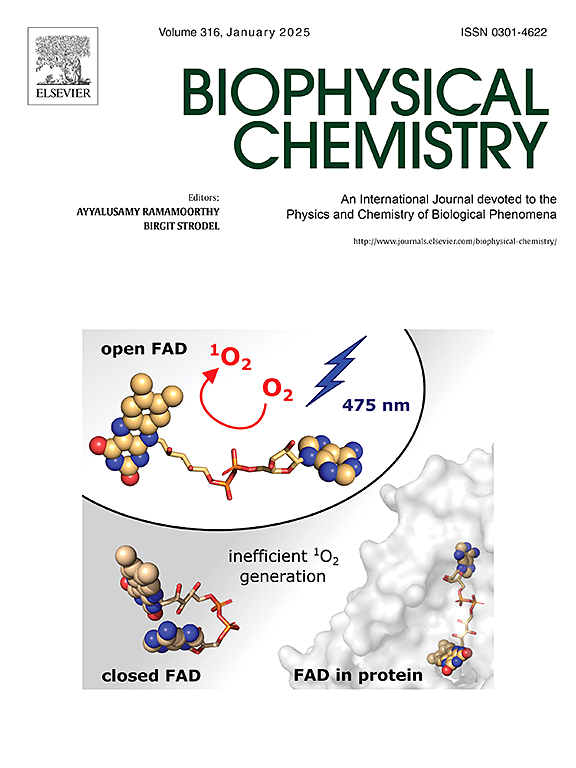甲乙胺对a - β42聚集机制的影响及其分子动力学模拟
IF 2.2
3区 生物学
Q2 BIOCHEMISTRY & MOLECULAR BIOLOGY
引用次数: 0
摘要
本研究研究了杀菌剂嘧霉胺对体外淀粉样蛋白-β 42 (a -β 42)肽聚集的影响。结果表明,乙胺甲乙胺加速了a - β42的聚集动力学,这一点在试管和微孔板实验中都得到了硫黄素T (ThT)荧光分析的证实。采用单分子技术和分子动力学模拟相结合的方法,阐明了嘧霉胺对A - β42聚集机理的复杂影响。纳米孔实验表明,乙胺虫胺在滞后期促进了小聚物(6-13.5 nm)的形成,而在对照条件下没有检测到。共聚焦荧光光谱显示,乙胺乙胺诱导形成更大的β-片结构聚集体。在预先形成的种子存在的情况下,嘧胺虫胺表现出双重作用,可能是通过与新形成的小种子的联合作用,将现有的原纤维分裂成更小的物种,并促进聚集。分子动力学模拟证实了乙胺对原纤维的亲和力高于单体,并减弱了单体与原纤维的相互作用。总的来说,本研究阐明了乙胺对a - β42聚集的复杂影响,包括促进初级成核、纤维断裂和调节单体-纤维相互作用。这些发现为杀虫剂等环境因素如何影响与阿尔茨海默病相关的淀粉样蛋白聚集过程提供了重要的机制见解。本文章由计算机程序翻译,如有差异,请以英文原文为准。

Effect of pyrimethanil on aβ42 aggregation mechanisms revealed at single entity level and molecular dynamic simulations
This study investigated the impact of pyrimethanil, a fungicide, on the aggregation of amyloid-β 42 (aβ42) peptides in vitro. The findings demonstrated that pyrimethanil accelerated aβ42 aggregation kinetics, as evidenced by thioflavin T (ThT) fluorescence assays in both tube and microplate experiments. A combination of single molecule techniques and molecular dynamics simulations is used to elucidate the complex effects of pyrimethanil on aβ42 aggregation mechanism. Nanopore experiments indicated that pyrimethanil promoted the formation of small oligomers (6-13.5 nm) during the lag phase, which were not detected under control conditions. Confocal fluorescence spectroscopy revealed that pyrimethanil induced the formation of larger β-sheet structured aggregates. In the presence of preformed seeds, pyrimethanil exhibited a dual role by fragmenting existing fibrils into smaller species and enhancing aggregation, likely through combined effects with the newly formed smaller seeds. Molecular dynamics simulations confirmed that pyrimethanil has a higher affinity for fibrils than monomers and weakens monomer-fibril interactions. Overall, this study elucidates the complex effects of pyrimethanil on aβ42 aggregation, involving promotion of primary nucleation, fibril fragmentation, and modulation of monomer-fibril interactions. These findings provide important mechanistic insights into how environmental factors like pesticides may influence amyloid aggregation processes relevant to Alzheimer's disease.
求助全文
通过发布文献求助,成功后即可免费获取论文全文。
去求助
来源期刊

Biophysical chemistry
生物-生化与分子生物学
CiteScore
6.10
自引率
10.50%
发文量
121
审稿时长
20 days
期刊介绍:
Biophysical Chemistry publishes original work and reviews in the areas of chemistry and physics directly impacting biological phenomena. Quantitative analysis of the properties of biological macromolecules, biologically active molecules, macromolecular assemblies and cell components in terms of kinetics, thermodynamics, spatio-temporal organization, NMR and X-ray structural biology, as well as single-molecule detection represent a major focus of the journal. Theoretical and computational treatments of biomacromolecular systems, macromolecular interactions, regulatory control and systems biology are also of interest to the journal.
 求助内容:
求助内容: 应助结果提醒方式:
应助结果提醒方式:


